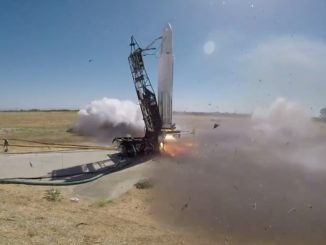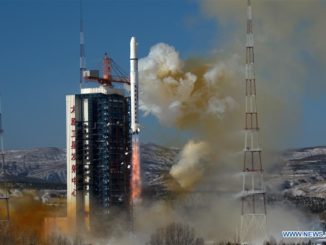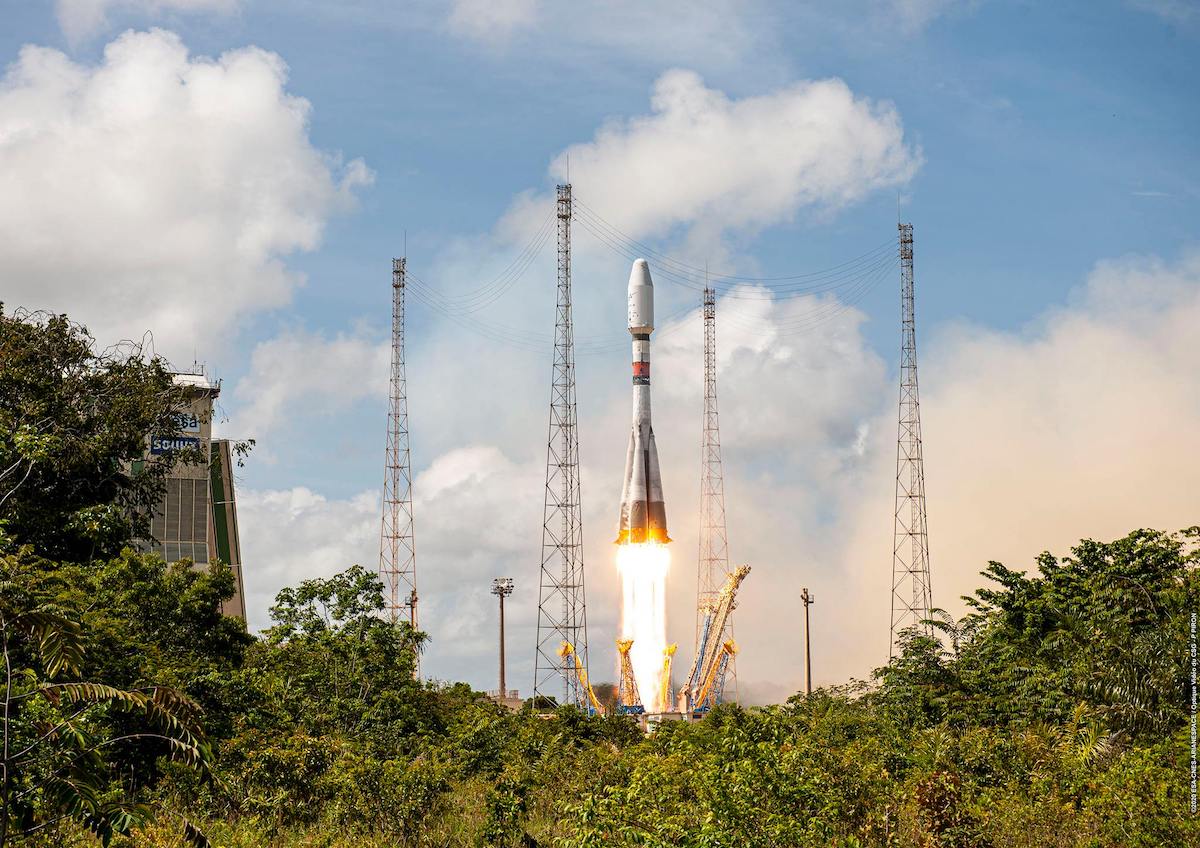
An optical reconnaissance satellite for the French military took off atop a Soyuz launcher Tuesday, riding the Russian-made rocket from a tropical spaceport in South America into a 300-mile-high polar orbit to begin a 10-year mission surveying the globe.
France’s CSO 2 spy satellite joins CSO 1, an identical craft launched in 2018, to continue replacing the French military’s 1990s- and 2000s-era Helios family of reconnaissance satellites.
The new military spysat lifted off on a Soyuz ST-A rocket at 11:42:07 a.m. EST (1642:07 GMT) from the European-operated Guiana Space Center in South America. Launch occurred at 1:42 p.m. local time at the spaceport in French Guiana.
Running more than eight months late due to delays primarily caused by the coronavirus pandemic, the mission succeeded in delivering the 7,852-pound (3,562-kilogram) CSO 2 spacecraft to an on-target orbit around 300 miles (480 kilometers) above Earth.
The Soyuz launcher’s four kerosene-fueled first stage boosters shut down and dropped away from the rocket around two minutes after liftoff, followed by separation of the Soyuz payload shroud and core stage. A third stage engine fired next, then released a Russian Fregat upper stage for a pair of engine burns to place the CSO 2 spacecraft in the proper orbit for deployment.
Ground teams in French Guiana confirmed separation of the CSO 2 satellite around one hour liftoff, as the spacecraft flew over a European Space Agency ground station in Australia.
“Mission perfectly accomplished,” said Stéphane Israël, CEO of Arianespace, the French company that oversees launch operations in French Guiana.
“It’s a really moving moment, and great news for the French Armed Forces,” said Caroline Laurent, director of orbital systems at CNES, the French space agency, a partner for the French military on the CSO program. “Personally speaking, I think it is the best Earth observation satellite in the world.”
The CSO 2 spacecraft is set to provide the highest-resolution Earth observation images ever produced by a European satellite. The first images from CSO 2 are expected to be downlinked within about two weeks of launch, according to Laurent.
“We launched a magnificent satellite,” said Maj. Gen. Michel Friedling, head of French Space Command. “It will producing images of extraordinary quality. we are very much looking forward to this. Our military operators are behind their desks awaiting these images.”
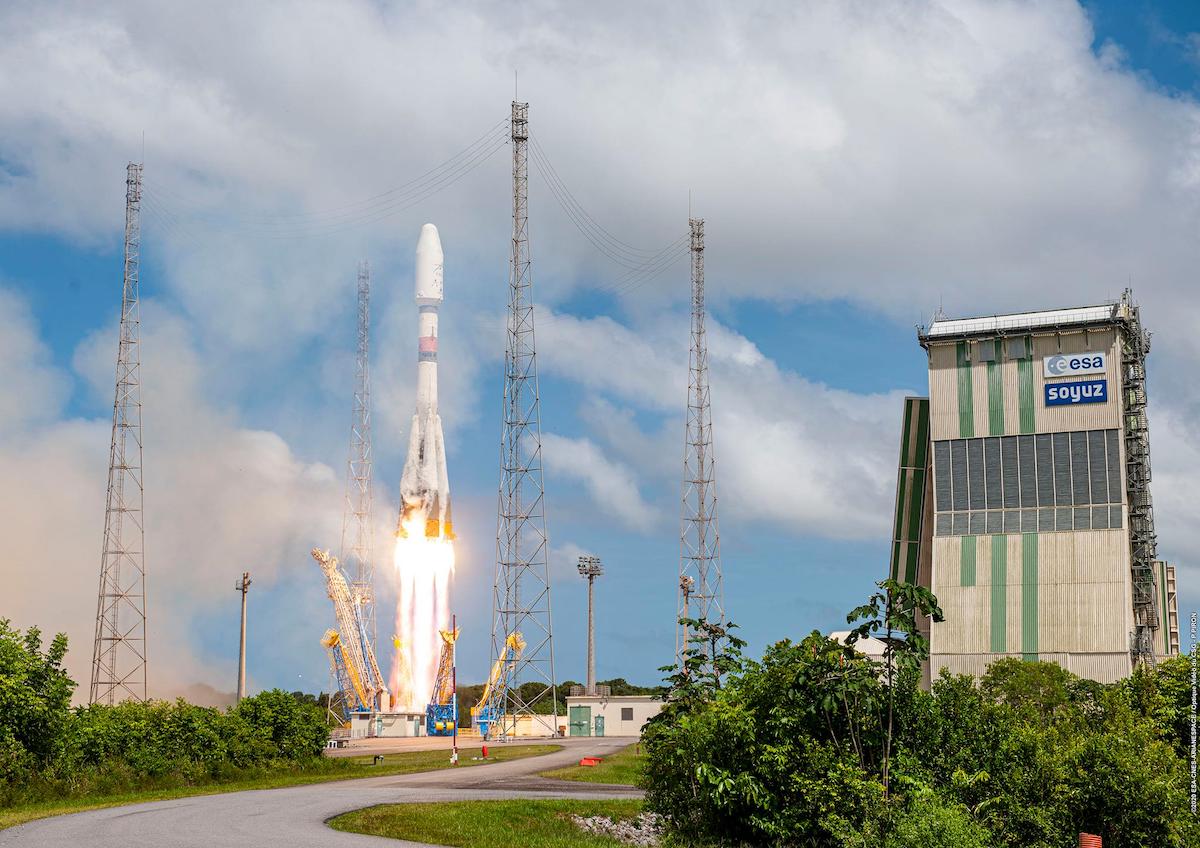
CSO 2 is the second satellite to join the French military’s Composante Spatiale Optique, or CSO, series of orbiting reconnaissance platforms.
France’s CSO 1 satellite launched on a Soyuz rocket in December 2018, and the third and final CSO satellite is scheduled to launch on Europe’s new Ariane 6 rocket in 2022.
While CSO 1 launched into an orbit around 500 miles (800 kilometers) in altitude, the CSO 2 spacecraft flies 200 miles (about 300 kilometers) closer to Earth. In that orbit, the satellite will capture sharper images for French military planners and intelligence analysts.
The CSO satellites are replacing France’s Helios family of military surveillance satellites, the last of which launched aboard an Ariane 5 rocket in 2009.
The new CSO satellites boast better global imaging capabilities than their Helios predecessors, and can take more pictures in a single overhead pass than the Helios spysats, according to the French Ministry of the Armed Forces.
The CSO satellites reportedly have a resolution of around 14 inches, or 35 centimeters, from the 500-mile-high orbit. From the lower 300-mile-high perch, CSO 2’s resolution is predicted to be better than 8 inches, or around 20 centimeters. For comparison, the new WorldView Legion commercial Earth-imaging satellites being developed by DigitalGlobe have a resolution of about 11.4 inches, or 29 centimeters.
The imaging capabilities of the U.S. government’s spy satellites are classified.
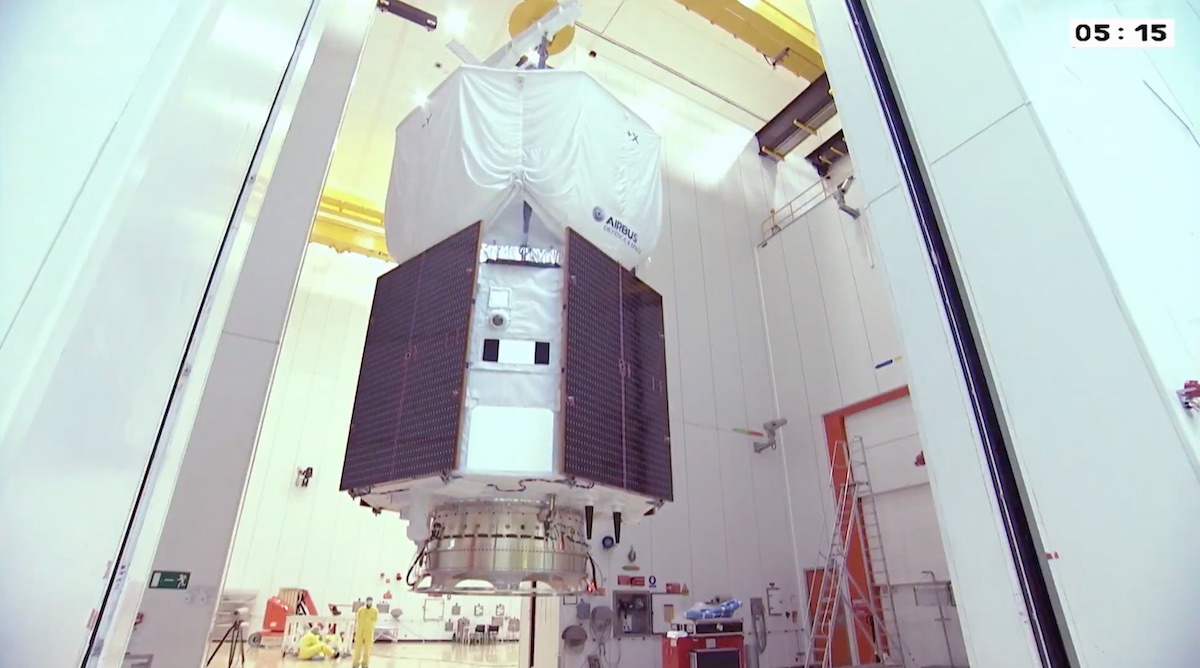
Placing the CSO 2 satellite into a lower orbit allows it to “supply imagery at the highest possible level of resolution, quality and analytical precision,” CNES said on its website.
The improved imaging quality from CSO 2, flying in its lower orbit, makes the new satellite well-suited for follow-up observations from other satellites in the fleet. CSO 2 could help identify targets and reveal information not visible to satellites in higher orbits, which have a broader field-of-view.
In its low-altitude orbit, CSO 2 could identify the details of a car, according to Nadège Roussel, chief weapons engineer at DGA, the French military’s procurement agency.
“Such level of detail is real operational asset, and its performance makes this a unique system in Europe,” she said.
The three CSO satellites are identical, other than an adjustment in the focusing of the optical instrument on CSO 2 to allow it to take pictures from a lower altitude, according to Pierre-Emmanuel Martinez, CSO 2 satellite manager at CNES.
The new-generation CSO spy satellite fleet is costing the French government more than $1.5 billion, including spacecraft, launch and ground system upgrade expenses, according to French authorities. The program is funded through the DGA, and the French space agency CNES is responsible for in-orbit testing, satellite operations, and the purchasing of the spacecraft and launch services.
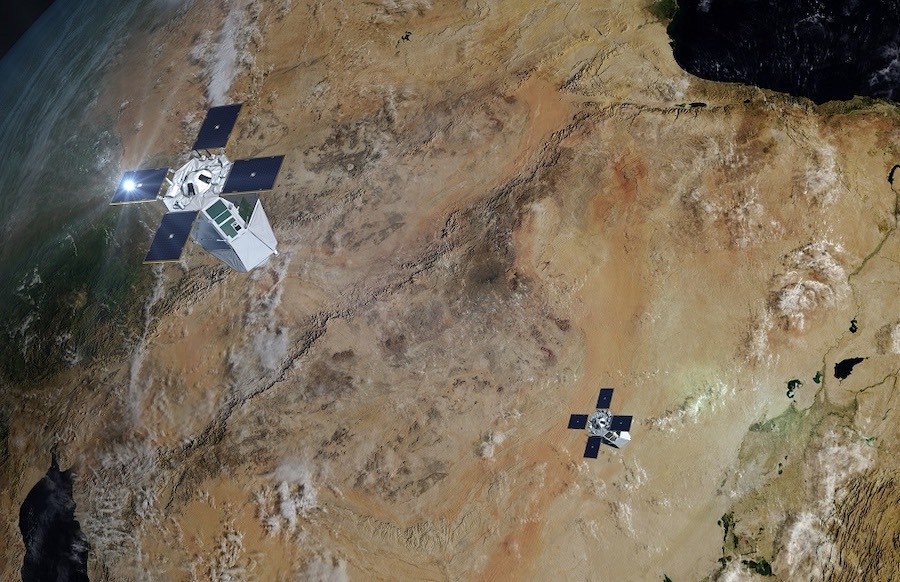
The French government has agreements to share optical imagery from the CSO satellites with the governments of Germany, Sweden, Belgium, and Italy, officials said. In exchange, the French military receives imagery from German and Italian radar observation satellites, which are designed for day-or-night, all-weather surveillance, and access to a ground station in Sweden.
The CSO satellites will also provide intelligence agencies and military officials imagery day-or-night in visible and infrared bands. The infrared imaging capability is an improvement over the Helios fleet, an upgraded enabled by the introduction of cryogenic cooling systems to chill infrared detectors on the CSO satellites.
Each CSO spacecraft features an agile pointing capability, allowing rapid steering from target to target, and enabling views from different look angles for three-dimensional stereo surveillance products.
French officials said reconnaissance imagery from the CSO satellites are useful in obtaining information about inaccessible regions, evaluating the strength of enemy military forces, and identifying civilians in close proximity to the battlefield. The images can help prepare plans for airstrikes, locate coordinates to guide missiles, avoid collateral damage to civilians, and allow commanders to evaluate the effectiveness of strikes by comparing images taken before and after a military operation.
The CSO 2 satellite also features a new autonomous orbit control capability, allowing the spacecraft to maintain its altitude and counteract atmospheric drag using quick burns of on-board thrusters. The satellite can perform the autonomous control maneuvers over the ocean and be ready to resume imaging operations once back over land, according to the French military.
The three CSO satellites were built by Airbus, with optical imaging instruments produced by Thales Alenia Space. CNES controls the satellites from a center in Toulouse, France, and the French military receives images at an airbase in Creil, France.
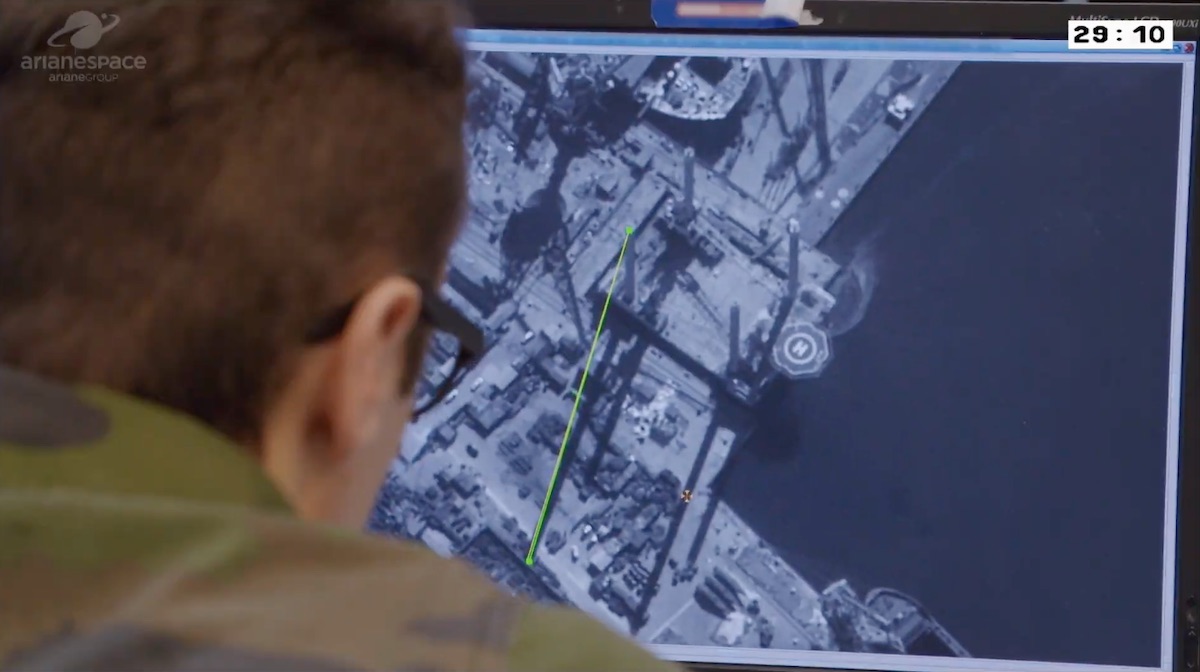
Airbus won the contract to build the CSO satellites in 2010, and the French government approved construction of a third CSO satellite after Germany committed to join the program in 2015.
“Providing the most modern and efficient observation capability for the safety of our citizens, as well as the sovereignty and independence of France and Europe, CSO is a real game changer in terms of resolution, complexity, safety of transmission, reliability and availability: only a couple of nations can claim such a capability,” said Jean-Marc Nasr, head of Airbus Space Systems.
“Today we are celebrating the launch of CSO 2, featuring the most powerful ‘space camera’ ever built in Europe,” said Hervé Derrey, president and CEO of Thales Alenia Space. “We are very proud to have built its telephoto lens and electronics, the brains of the satellite. To develop this instrument, we called on the full sum of our experience in building the optical instruments for the six satellites in the Helios 1, Helios 2 and Pleiades families, allowing us to offer an instrument with unrivaled performance.”
Email the author.
Follow Stephen Clark on Twitter: @StephenClark1.

